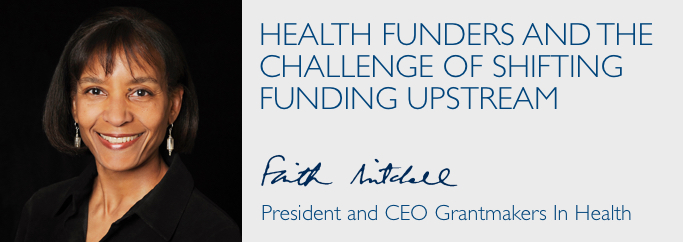
The uncertain future of the ACA has focused attention for the past several months on policies related to health care, but we should not lose sight of the factors outside of the health care system that profoundly shape health. Community development, housing, and domestic violence—all discussed in this month’s Bulletin—are among them.
U.S. health policy largely ignores the social determinants of health, despite evidence showing that residents of nations that have higher ratios of spending on social services to spending on health care services have better health and live longer. In fact, a recent National Academy of Medicine report concludes that a health policy framework addressing social and behavioral determinants of health would achieve better population health, less inequality, and lower costs than our current policies (Adler, Et Al 2016).
Many foundation leaders concur with this conclusion. In our 35th anniversary survey of GIH board members and board alumni, several identified the social determinants of health as a primary challenge—now and in the future—for health philanthropy. To effectively address the social determinants, it was frequently suggested that health funders develop partnerships outside the traditional health sector. These actions were linked not only to better population health, but also to achieving the goal of health equity.
As David Fukuzawa framed it, “There is a need to address health equity, to make increased investments in improving the underlying conditions that drive health, and to increase funding in multisectoral and multidisciplinary efforts to address inequity.”
Others stated:
- We need to cultivate and leverage strategic relationships that will identify and solve problems together, create a shared value of health across sectors, and foster champions for health who can serve as translators and interpreters across sectors, disciplines, and ideologies.
- Health funders should be responding to the needs of populations that are most threatened by the social and political environment. For example, how are funders thinking about and addressing the needs of marginalized populations like immigrants, criminal justice-involved groups, and people impacted by gun violence? While there is increasing interest among funders in these issues, the response could be bolder and more intentional. Viewing issues through a more inclusive public health lens would be helpful in broadening the reach of philanthropic health dollars.
- We have to keep the focus on the social determinants of health and population health, showing and demonstrating the proof of concept and spreading and scaling effective strategies.
- We have to move upstream to address the social determinants of health and the U.S. social compact (the implicit agreement among the members of a society to cooperate for social benefits).
- We have to educate our “non-health” colleagues about the importance of cross-sector collaboration that provides win-win results, such as improvements to both education and health, or to both housing and health.
- We need mission investing at the social determinant level to address health equity.
- We should seek ways to increase the focus on public health and particularly environmental health and climate issues. Those broader frameworks have always had a bigger impact on population health than health delivery and systems issues.
- The fine work many foundations are doing in the health and racial equity arena should continue. We should intensify the connections between foundations and other groups outside of the health field in order to address the root causes of health disparities, e.g., poverty, income inequality, place, race, and ethnicity.
- If we know the social determinants are responsible for the majority of health outcomes, we should consider how to shift funding upstream, toward root causes and prevention, using the $3.2 trillion in the health system to do so.
In upcoming letters, I will share the insights and recommendations of GIH Board members and alumni on additional areas of work, including workforce education and clinical care, and health funders as social justice leaders.

